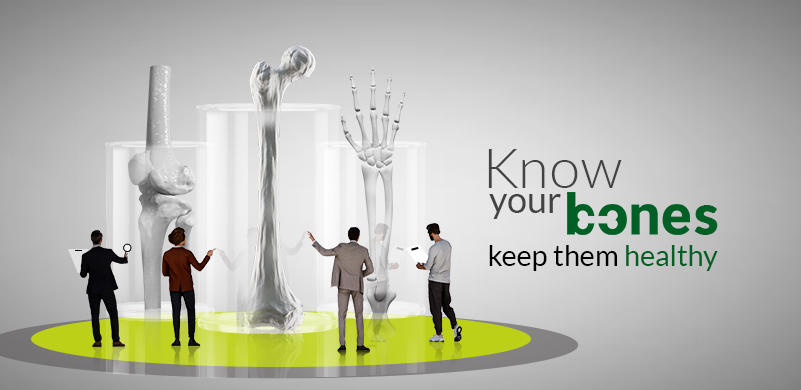© Copyright 2019. Regrow Biosciences Pvt Ltd. All Rights Reserved
Blog
© Copyright 2019. Regrow Biosciences Pvt Ltd. All Rights Reserved
Blog
Know your bones – keep them healthy
25th August 2022

Bones make up your skeleton and protect your internal organs. Childhood and young adulthood are bone-building years where they constantly grow and strengthen. Old bones are resorbed, and new bones are formed through bone remodeling process.
Throughout your lifetime, your skeleton loses old bone and forms new bones until it reaches peak bone mass (up to 25 years of age). After this period, the bone formation rate is massively affected. Decreased bone formation occurs after the skeletal growth phase and after four-seven of menopause (in women). The estrogen hormone levels in women undergo sudden decline and experience a bone loss of up to 20% or, in some cases, more. Lower bone formation results in net bone loss and lowers bone density. A decrease in bone density causes osteoporosis (a condition with porous bones).
Apart from the new bone formation and replacement of old bones, two important components ensure bone health and bone density – Collagen which brings flexibility to the bone, and the Calcium-phosphate complex that makes bones stronger. For this, nutrient supplementation such as magnesium, phosphorus, calcium, vitamins D, B6, B12, and K through food intake followed by regular physical activity helps bone density and thus bone strength.
Consumption of high animal protein causes calcium elimination through the kidneys. Excess consumption of coffee, sodium-rich, oxalate-rich foods such as spinach and 100% wheat bran causes calcium loss or decreases calcium retention, or decreases calcium absorption. Consume calcium supplements a couple of hours before or after if you are taking 100% wheat bran for your diet. Apart from diet, a sedentary lifestyle, smoking, and alcohol consumption affect osteoporosis.
Following is the BHOF (Bone Health & Osteoporosis foundation) recommendation of daily Vitamin D and calcium consumption by men and women as per the age –
| Women | Calcium | Vitamin D |
|---|---|---|
| 50 years and younger | 1000 mg | 400 – 800 units |
| 51 years and older | 1200 mg | 800 – 1000 units |
| Men | Calcium | Vitamin D |
|---|---|---|
| 50 years and younger | 1000 mg | 400 – 800 units |
| 51-70 years old | 1000 mg | 800 – 1000 units |
| 71 years and older | 1200 mg | 800 – 1000 units |
1) Weight-bearing exercise (30 minutes a day, and 5 days a week),
2) Resistance exercise (twice a week on days when there is no weight-bearing exercise),
3) Functional exercise (every day).
Anorexia nervosa, an eating disorder more common in teenage girls and young women causes estrogen decline that causes bone loss. Hyperparathyroidism causes bone loss and Hyperthyroidism causes weak muscles and fragile bones. Patients affected with rheumatoid arthritis or undergoing treatment with corticosteroids are at high risk of osteoporosis. Amongst drugs from aluminum-based antacids and medroxyprogesterone acetate to cancer medications, various kinds of drugs affect bone loss and bone strength.
Bone density can be measured by various tests such as –
1) Quantitative ultrasound
2) Quantitative computed tomography
3) Peripheral Quantitative computed tomography
4) Dual-energy x-ray absorptiometry
5) Peripheral Dual-energy x-ray absorptiometry
BMD test result is interpreted as T-score. It is measured as the degree of standard deviation (SD) which is nothing but the difference between your bone density and that of a healthy individual. A decrease of 1SD in BMD means a 10-15% decrease in bone density compared to the healthy individual.
| T-Score | Bone Health status |
|---|---|
| -1.0 or higher | Normal bone health |
| -1.0 to -2.5 | Osteopenia (low bone mass) |
| -2.5 or lower | Osteoporosis (vulnerable stage to fractures and brittle bones) |
Apart from this, an osteoporosis risk assessment tool, the FRAX score, can be given by a Dual-energy x-ray absorptiometry report or assessed using a web-based version. FRAX estimates your chances of breaking bones, especially of the hips, spine, forearm, and shoulder, over the next ten years. FRAX tool is useful in men or women older than 50 and those diagnosed with low bone density. A T-score of -2.5 indicates a >20% risk of hip or significant osteoporosis-related fractures in the next 10 years.
Treatment of osteoporosis can be done by:
1) Anti-resorption (anti-bone loss) drugs such as bisphosphonates (Alendronate, Risedronate, Ibandronate, Zoledronic acid)
2) Estrogen-like medications such as Tamoxifen (post-menopausal bone loss),
3) Targeted monoclonal antibody therapies such as Denosumab to improve the bone mineral density
4) Calcitonin nasal spray, etc.
As much as most of these treatments can offer their best to minimize the damage or protect further from bone mineral loss, it is essential to take a balanced diet rich in calcium and other minerals and vitamins with regular physical activity without a sedentary lifestyle or lifestyle habits such as smoking or alcohol.